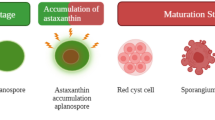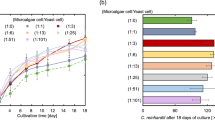Abstract
Objective
To analyze the involvement of the octadecanoic (OCDA) pathway in the accumulation of sanguinarine induced by yeast extract (YE) in cell suspension cultures of Argemone mexicana (Papaveraceae).
Results
Exposure to YE promoted sanguinarine accumulation. This was not observed when they were exposed to methyl jasmonate (MeJa). Use of diethyldithiocarbamic acid (DIECA), an inhibitor of the OCDA pathway, resulted in partial impairment of this response. Exogenous application of MeJa did not reverse this effect in DIECA-exposed cultures. qRT-PCR revealed that the accumulation of transcripts corresponding to the berberine bridge enzyme gene, which was induced by YE exposure, was blocked by OCDA pathway and reversed by exogenous MeJa. Interestingly, this response pattern could not be observed on dihydrobenzophenanthridine oxidase enzyme activity, which was promoted by YE, but unaffected by either OCDA or MeJa.
Conclusion
Results suggest partial involvement of OCDA pathway in this response.



Similar content being viewed by others
References
Archambault J, Williams RD, Bédard C, Chavarie C (1996) Production of sanguinarine by elicited plant cell culture I. Shake flask suspension cultures. J Biotechnol 46:95–105
Cho HY, Lee-Parsons CWT, Yoon S-YH, Rhee HS, Park JM (2007) Enhanced benzophenanthridine alkaloid production and protein expression with combined elicitor in Eschscholtzia californica suspension cultures. Biotechnol Lett 29:2001–2005
Cho HY, Rhee HS, Yoon SY, Park JM (2008a) Differential induction of protein expression and benzophenanthridine alkaloid accumulation in Eschscholzia californica suspension cultures by methyl jasmonate and yeast extract. J Microbiol Biotechnol 18:255–262
Cho HY, Son SY, Rhee HS, Yoon SYH, Lee-Parsons CW, Park JM (2008b) Synergistic effects of sequential treatment with methyl jasmonate, salicylic acid and yeast extract on benzophenanthridine alkaloid accumulation and protein expression in Eschscholzia californica suspension cultures. J Biotechnol 135:117–122
Derksen H, Rampitsch C, Daayf F (2013) Signaling cross-talk in plant disease resistance. Plant Sci 207:79–87
Guízar-González C, Trujillo-Villanueva K, Monforte-González M, Vázquez-Flota F (2012) Sanguinarine and dihydrosanguinarine accumulation in Argemone mexicana (L.) cell suspension cultures exposed to yeast extract. J Mex Chem Soc 56:19–22
Hagel JM, Facchini PJ (2013) Benzylisoquinoline alkaloid metabolism—a century of discovery and a brave new world. Plant Cell Physiol 54:647–672
Hartmann T (2007) From waste products to ecochemicals: fifty years research of plant secondary metabolism. Phytochemistry 68:2831–2846
Ignatov A, Clark WG, Cline SD, Psenak M, Krueger J, Coscia CJ (1999) Elicitation of dihydrobenzophenanthridine oxidase in Sanguinaria canadensis cell cultures. Phytochemistry 46:1141–1144
Menke FLH, Parchmann S, Mueller MJ, Kijne JW, Memelink J (1999) Involvement of the octadecanoid pathway and protein phosphorylation in fungal elicitor-induced expression of terpenoid indole alkaloid biosynthetic genes in Catharanthus roseus. Plant Physiol 119:1289–1296
Monforte-González M, Guízar-González C, Rubio-Piña J, Carrillo-Pech M, Vázquez-Flota F (2012) Berberine and sanguinarine quantitation in Argemone mexicana L. (Papaveraceae) tissues by TLC-in situ fluorography. J Planar Chromatogr—Mod TLC 25:358–360
Rubio-Piña J, Vazquez-Flota F (2013) Pharmaceutical applications of the benzylisoquinoline alkaloids from Argemone mexicana L. Curr Top Med Chem 13:2200–2207
Simon P (2003) Q-Gene: processing quantitative real-time RT–PCR data. Bioinformatics 19:1439–1440
Trujillo-Villanueva K, Rubio-Piña J, Monforte-González M, Vázquez-Flota F (2010) Fusarium oxysporum homogenates and jasmonate induce a limited sanguinarine accumulation in Argemone mexicana cell cultures. Biotechnol Lett 32:1005–1009
Trujillo-Villanueva KA, Rubio-Piña J, Monforte-González M, Ramírez-Benítez E, Vázquez-Flota F (2012) The sequential exposure to jasmonate, salicylic acid and yeast extract promotes sanguinarine accumulation in Argemone mexicana cell cultures. Biotechnol Lett 34:379–385
Vázquez-Flota F, Monforte-González M, Guízar-González C, Rubio-Piña J, Trujillo-Villanueva K, Coello-Coello J (2012) Establishment of a sanguinarine producing cell suspension culture of Argemone mexicana L. (Papaveraceae). Induction of alkaloid accumulation. In: Loyola-Vargas VM, Ochoa-Alejo N (eds) Plant cell culture protocols, 3rd edn. The Humana Press/Springer, New York, pp 271–276
Weiss D, Baumert A, Vogel M, Roos W (2006) Sanguinarine reductase, a key enzyme of benzophenanthridine detoxification. Plant, Cell Environ 29:291–302
Acknowledgments
This work was supported by CONACYT (National Council for Science and Technology, Mexico), Grant CB-2012-0181800.
Supporting information
Supplementary Figure 1. Aspect of the A. mexicana AmMiF cell suspensions exposed to different doses of methyl jasmonate (MeJa) or yeast extract (YE) for 24 h. Cultures were treated as described in the Materials and methods section. Controls were exposed to water (for YE) or 10 % ethanol (for MeJa). Figures on top of photographs correspond to the concentration applied in μM for MeJa or mg l−1 for YE.
Author information
Authors and Affiliations
Corresponding author
Additional information
Cecilia Guízar-González and Miriam Monforte-González have contributed equally to this work.
Electronic supplementary material
Below is the link to the electronic supplementary material.
Rights and permissions
About this article
Cite this article
Guízar-González, C., Monforte-González, M. & Vázquez-Flota, F. Yeast extract induction of sanguinarine biosynthesis is partially dependent on the octadecanoic acid pathway in cell cultures of Argemone mexicana L., the Mexican poppy. Biotechnol Lett 38, 1237–1242 (2016). https://doi.org/10.1007/s10529-016-2095-2
Received:
Accepted:
Published:
Issue Date:
DOI: https://doi.org/10.1007/s10529-016-2095-2




